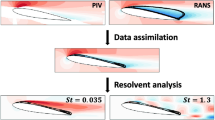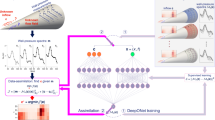Abstract
This paper provides guidelines for an effective artificial neural networks (ANNs) design to aid stabilized finite element schemes. In particular, ANNs are used to estimate the stabilization parameter of the streamline upwind Petrov–Galerkin (SUPG) stabilization scheme for singularly perturbed problems. The effect of the artificial neural network (ANN) hyper-parameters on the accuracy of ANNs is found by performing a global sensitivity analysis. First, a Gaussian process regression metamodel of the artificial neural networks is obtained. Next, analysis of variance is performed to obtain Sobol’ indices. The total-order Sobol’ indices identify the hyper-parameters having the maximum effect on the accuracy of the ANNs. Furthermore, the best-performing and the worst-performing networks are identified among the candidate ANNs. Our findings are validated with the help of one-dimensional test cases in the advection-dominated flow regime. This study provides insights into hyper-parameters’ effect and consequently aids in building effective ANN models for applications involving nonlinear regression, including estimation of SUPG stabilization parameters.

















Similar content being viewed by others
References
Abgrall, R., Ricchiuto, M.: High Order Methods for CFD. Wiley, Hoboken (2017)
Aimone, J.B., Parekh, O., Severa, W.: Neural computing for scientific computing applications: more than just machine learning. In: Proceedings of the Neuromorphic Computing Symposium, NCS ’17. Association for Computing Machinery, New York, NY, USA (2017). https://doi.org/10.1145/3183584.3183618
Brooks, A.N.T.: Streamline upwind/petrov-galerkin formulations for convection dominated flows with particular emphasis on the incompressible Navier–Stokes equations. Comput. Methods Appl. Mech. Eng. 32(1–3), 199–259 (1982). https://doi.org/10.1016/0045-7825(82)90071-8
Barron, A.R.: Universal approximation bounds for superpositions of a sigmoidal function. IEEE Trans. Inf. Theory 39(3), 930–945 (1993). https://doi.org/10.1109/18.256500
Baudin, M., Dutfoy, A., Iooss, B., Popelin, A.L.: OpenTURNS: an industrial software for uncertainty quantification in simulation, pp. 1–38. Springer, Cham (2016)
Behzadi, F., Newman, J.C.: A semi-discrete SUPG method for contaminant transport in shallow water models. Procedia Comput. Sci. 80, 1313–1323 (2016). https://doi.org/10.1016/j.procs.2016.05.476
Bochev, P.B., Gunzburger, M.D., Shadid, J.N.: Stability of the SUPG finite element method for transient advection-diffusion problems. Comput. Methods Appl. Mech. Eng. 193(23–26), 2301–2323 (2004). https://doi.org/10.1016/j.cma.2004.01.026
Brooks, A.N., Hughes, T.J.R.: Streamline upwind/Petrov–Galerkin formulations for convection dominated flows with particular emphasis on the incompressible Navier–Stokes equations. Comput. Methods Appl. Mech. Eng. 32, 199–259 (1982)
Brunton, S.L., Noack, B.R., Koumoutsakos, P.: Machine learning for fluid mechanics. Ann. Rev. Fluid Mech. 52(1), 477–508 (2020). https://doi.org/10.1146/annurev-fluid-010719-060214
Curtin, R.R., Cline, J.R., Slagle, N.P., March, W.B., Ram, P., Mehta, N.A., Gray, A.G.: MLPACK: a scalable C++ machine learning library. J. Mach. Learn. Res. 14, 801–805 (2013)
Curtin, R.R., Edel, M., Lozhnikov, M., Mentekidis, Y., Ghaisas, S., Zhang, S.: Mlpack 3: a fast, flexible machine learning library. J. Open Source Softw. 3(726), 10 (2018). https://doi.org/10.21105/joss.00726
Cybenko, G.: Approximation by Superpositions of a Sigmoidal Function. Math. Control Signals Syst. 2, 303–314 (1989)
Cybenko, G.: Neural networks in computational science and engineering. IEEE Comput. Sci. Eng. 3(1), 36–42 (1996). https://doi.org/10.1109/99.486759
Discacciati, N., Hesthaven, J.S., Ray, D.: Controlling oscillations in high-order discontinuous Galerkin schemes using artificial viscosity tuned by neural networks. J. Comput. Phys. 409, 109304 (2020). https://doi.org/10.1016/j.jcp.2020.109304
Burman, E.: Consistent supg-method for transient transport problems: stability and convergence. Comput. Methods Appl. Mech. Eng. 199(17–20), 1114–1123 (2010). https://doi.org/10.1016/j.cma.2009.11.023
Burman, E.P.: Edge stabilization for galerkin approximations of convection-diffusion-reaction problems. Comput. Methods Appl. Mech. Eng. 193(15–16), 1437–1453 (2004). https://doi.org/10.1016/j.cma.2003.12.032
Burman, E., Fernandez, M.P.: Continuous interior penalty finite element method for Oseen’s equations. SIAM J. Numer. Anal. 44(3), 1248–1274 (2006). https://doi.org/10.1137/040617686
Fernández-Navarro, F., Carbonero-Ruz, M., Alonso, D.B., Torres-Jimenez, M.: Global sensitivity estimates for neural network classifiers. IEEE Trans. Neural Netw. Learn. Syst. 28(11), 2592–2604 (2017). https://doi.org/10.1109/TNNLS.2016.2598657
Fock, E.: Global sensitivity analysis approach for input selection and system identification purposes—a new framework for feedforward neural networks. IEEE Trans. Neural Netw. Learn. Syst. 25(8), 1484–1495 (2014). https://doi.org/10.1109/TNNLS.2013.2294437
de Frutos, J., García-Archilla, B., John, V., Novo, J.: An adaptive SUPG method for evolutionary convection-diffusion equations. Comput. Methods Appl. Mech. Eng. 273, 219–237 (2014). https://doi.org/10.1016/j.cma.2014.01.022
Ganesan, S., John, V., Matthies, G., Meesala, R., Abdus, S., Wilbrandt, U.: An object oriented parallel finite element scheme for computations of pdes: design and implementation. In: 2016 IEEE 23rd International Conference on High Performance Computing Workshops (HiPCW) pp. 2–11 (2016). https://doi.org/10.1109/HiPCW.2016.023
Ganesan, S., Srivastava, S.: ALE-SUPG finite element method for convection-diffusion problems in time-dependent domains: conservative form. Appl. Math. Comput. 303, 128–145 (2017). https://doi.org/10.1016/j.amc.2017.01.032
Giere, S., Iliescu, T., John, V., Wells, D.: SUPG reduced order models for convection-dominated convection-diffusion-reaction equations. Comput. Methods Appl. Mech. Eng. 289, 454–474 (2015). https://doi.org/10.1016/j.cma.2015.01.020
Hecht-Nielsen, R.: Theory of the backpropagation neural network. In: International 1989 joint conference on neural networks, pp. 593–605 vol. 1 (1989)
Roos, H.G., Stynes, M.L.: Numerical Methods for Singularly Perturbed Differential Equations. Springer, Berlin (2008)
Hornik, K., Stinchcombe, M., White, H.: Multilayer feedforward networks are universal approximators. Neural Netw. 2(5), 359–366 (1989). https://doi.org/10.1016/0893-6080(89)90020-8
Iooss, B., Lemaître, P.: A review on global sensitivity analysis methods. Oper. Res./Comput. Sci. Interfaces Ser. 59, 101–122 (2015)
Jeon, Y.: Hybridized SUPG and upwind numerical schemes for convection dominated diffusion problems. J. Comput. Appl. Math. 275, 91–99 (2015). https://doi.org/10.1016/j.cam.2014.08.005
John, V., Knobloch, P.: On spurious oscillations at layers diminishing (SOLD) methods for convection-diffusion equations: part I—a review. Comput. Methods Appl. Mech. Eng. 196(17–20), 2197–2215 (2007). https://doi.org/10.1016/j.cma.2006.11.013
John, V., Novo, J.: Error analysis of the SUPG finite element discretization of evolutionary convection-diffusion-reaction equations. SIAM J. Numer. Anal. 49(3), 1149–1176 (2011)
Johnson, C., Nävert, U., Pitkäranta, J.: Finite element methods for linear hyperbolic problems. Comput. Methods Appl. Mech. Eng. 45(1–3), 285–312 (1984). https://doi.org/10.1016/0045-7825(84)90158-0
Kowalski, P.A., Kusy, M.: Determining the significance of features with the use of sobol method in probabilistic neural network classification tasks. In: Proceedings of the 2017 Federated Conference on Computer Science and Information Systems, FedCSIS 2017 11, 39–48 (2017). https://doi.org/10.15439/2017F225
LeVeque, R.J.: Numerical Methods for Conservation Laws. Birkhauser-Verlag, Basel (1990)
Li, R., Wu, Q., Zhu, S.: Proper orthogonal decomposition with SUPG-stabilized isogeometric analysis for reduced order modelling of unsteady convection-dominated convection-diffusion-reaction problems. J. Comput. Phys. 387(18), 280–302 (2019). https://doi.org/10.1016/j.jcp.2019.02.051
Lye, K.O., Mishra, S., Ray, D.: Deep learning observables in computational fluid dynamics. J. Comput. Phys. 410, 109339 (2020). https://doi.org/10.1016/j.jcp.2020.109339
Nasu, S., Nojima, K., Kawahara, M.: SUPG finite element method for adiabatic flows. Comput. Math. Appl. 66(3), 250–268 (2013). https://doi.org/10.1016/j.camwa.2013.05.003
Ray, D., Hesthaven, J.S.: An artificial neural network as a troubled-cell indicator. J. Comput. Phys. 367, 166–191 (2018). https://doi.org/10.1016/j.jcp.2018.04.029
Ray, D., Hesthaven, J.S.: Detecting troubled-cells on two-dimensional unstructured grids using a neural network. J. Comput. Phys. 397, 108845 (2019). https://doi.org/10.1016/j.jcp.2019.07.043
Codina, R.: Stabilization of incompressibility and convection through orthogonal sub-scales in finite element methods. Comput. Methods Appl. Mech. Eng. 190(13–14), 1579–1599 (2000). https://doi.org/10.1016/S0045-7825(00)00254-1
Saltelli, A.: Making best use of model evaluations to compute sensitivity indices. Comput. Phys. Commun. 145(2), 280–297 (2002). https://doi.org/10.1016/S0010-4655(02)00280-1
Schröder, L., Dimitrov, N.K., Aasted Sorensen, J.: Uncertainty propagation and sensitivity analysis of an artificial neural network used as wind turbine load surrogate model. J. Phys. Conf. Ser. (2020). https://doi.org/10.1088/1742-6596/1618/4/042040
Schulz, E., Speekenbrink, M., Krause, A.: A tutorial on Gaussian process regression: modelling, exploring, and exploiting functions. J. Math. Psychol. 85, 1–16 (2018). https://doi.org/10.1016/j.jmp.2018.03.001
Schwander, L., Ray, D., Hesthaven, J.S.: Controlling oscillations in spectral methods by local artificial viscosity governed by neural networks. J. Comput. Phys. 431, 110144 (2021). https://doi.org/10.1016/j.jcp.2021.110144
Ganesan, S.: An operator-splitting galerkin/supg finite element method for population balance equations: stability and convergence. ESAIM Math. Modell. Numer. Anal. 46(6), 1447–1465 (2012). https://doi.org/10.1051/m2an/2012012
Ganesan, S.L.: Stabilization by local projection for convection-diffusion and incompressible flow problems. J. Sci. Comput. 43(3), 326–342 (2010). https://doi.org/10.1007/s10915-008-9259-8
Sobol’, I.M.: Sensitivity estimates for non linear mathematical models. Math. Modell. Comput. Exp. 1, 407–414 (1993)
Sobol’, I.M.: Global sensitivity indices for nonlinear mathematical models and their Monte Carlo estimates. Math. Comput. Simul. 55, 271–280 (2001)
Sobol’, I.M., Tarantola, S., Gatelli, D., Kucherenko, S.S., Mauntz, W.: Estimating the approximation error when fixing unessential factors in global sensitivity analysis. Reliab. Eng. Syst. Saf. 92(7), 957–960 (2007). https://doi.org/10.1016/j.ress.2006.07.001
Hughes, T.J.R., Franca, L.P.G.: A new finite element formulation for computational fluid dynamics: Viii. The Galerkin/least-squares method. Comput. Methods Appl. Mech. Eng. 73(2), 173–189 (1989). https://doi.org/10.1016/0045-7825(89)90111-4
Veiga, M.H., Abgrall, R.: Towards a general stabilisation method for conservation laws using a multilayer perceptron neural network: 1D scalar and system of equations. In: Proceedings of the 6th European Conference on Computational Mechanics: Solids, Structures and Coupled Problems, ECCM 2018 and 7th European Conference on Computational Fluid Dynamics, ECFD 2018, pp. 2525–2539 (2020)
John, V.J.: Error analysis of the supg finite element discretization of evolutionary convection-diffusion-reaction equations. SIAM J. Numer. Anal. 49(3), 1149–1176 (2011). https://doi.org/10.1137/100789002
Wang, Z.J., Fidkowski, K., Abgrall, R., Bassi, F., Caraeni, D., Cary, A., Deconinck, H., Hartmann, R., Hillewaert, K., Huynh, H.T., Kroll, N., May, G., Persson, P.O., van Leer, B., Visbal, M.R.: High-order CFD methods: current status and perspective. International Journal for Numerical Methods in Fluids 72(Published online 24 January 2013 in Wiley Online Library (wileyonlinelibrary.com/journal/nmf)), 811–845 (2013). https://doi.org/10.1002/fld.3767
Wilbrandt, U., Bartsch, C., Ahmed, N., Alia, N., Anker, F., Blank, L., Caiazzo, A., Ganesan, S., Giere, S., Matthies, G., Meesala, R., Shamim, A., Venkatesan, J., John, V.: Parmoon—a modernized program package based on mapped finite elements. Comput. Math. Appl. 74, 74–88 (2016). https://doi.org/10.1016/j.camwa.2016.12.020
Yadav, S., Ganesan, S.: How deep learning performs with singularly perturbed problems? In: Proceedings—IEEE 2nd International Conference on Artificial Intelligence and Knowledge Engineering, AIKE 2019 pp. 293–297 (2019). https://doi.org/10.1109/AIKE.2019.00058
Acknowledgements
This work is partially supported by Ministry of Education, Government of India through the scheme for transformational and advanced research in science, MoE/STARS-1/388. Furthermore, S. M. Joshi would like to acknowledge the C. V. Raman PostDoc fellowship from IISc, Bangalore.
Author information
Authors and Affiliations
Corresponding author
Ethics declarations
Conflict of interest
The authors declare that they have no conflict of interest.
Additional information
Publisher's Note
Springer Nature remains neutral with regard to jurisdictional claims in published maps and institutional affiliations.
Appendix A
Appendix A



Rights and permissions
About this article
Cite this article
Joshi, S.M., Anandh, T., Teja, B. et al. On the choice of hyper-parameters of artificial neural networks for stabilized finite element schemes. Int J Adv Eng Sci Appl Math 13, 278–297 (2021). https://doi.org/10.1007/s12572-021-00306-9
Accepted:
Published:
Issue Date:
DOI: https://doi.org/10.1007/s12572-021-00306-9




